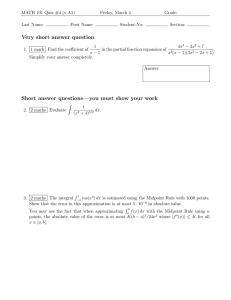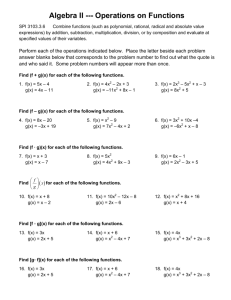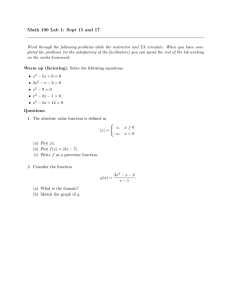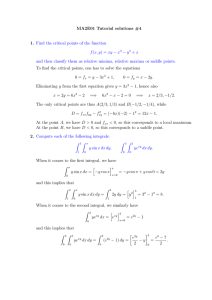1 SOLUTIONS NAME: STUDENT ID NUMBER:
advertisement
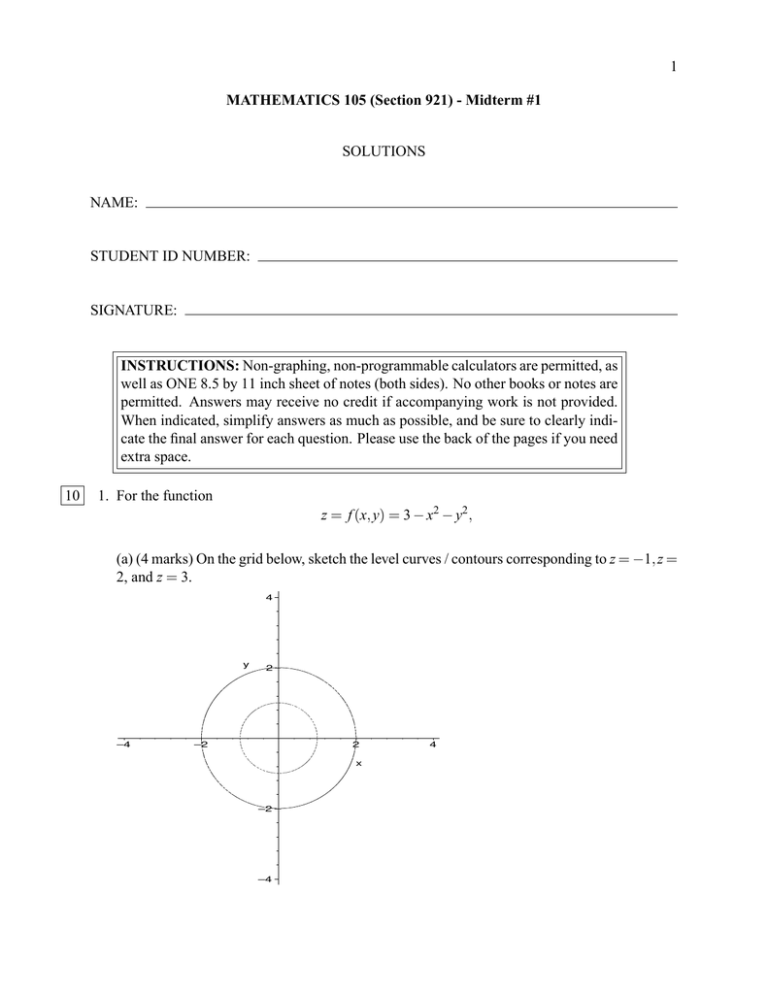
1 MATHEMATICS 105 (Section 921) - Midterm #1 SOLUTIONS NAME: STUDENT ID NUMBER: SIGNATURE: INSTRUCTIONS: Non-graphing, non-programmable calculators are permitted, as well as ONE 8.5 by 11 inch sheet of notes (both sides). No other books or notes are permitted. Answers may receive no credit if accompanying work is not provided. When indicated, simplify answers as much as possible, and be sure to clearly indicate the final answer for each question. Please use the back of the pages if you need extra space. 10 1. For the function z = f (x, y) = 3 − x2 − y2 , (a) (4 marks) On the grid below, sketch the level curves / contours corresponding to z = −1, z = 2, and z = 3. 4 y –4 2 –2 2 x –2 –4 4 2 (b) (3 marks) On the grid below, sketch the cross-section of f (x, y) that corresponds to y = 0 4 z –4 2 –2 2 4 x –2 –4 (c) (3 marks) Which of the figures below is the graph of the function f (x, y) = 3 − x2 − y2 ? (circle one) 4 4 6 3 3 2 4 2 z z z 1 1 2 –4 –4 (i) –2 2 4 y x 2 –2 –4 –2 4 4 y 4 x 2 2 4 –1 (ii) –1 –4 –2 2 (iii) 4 2 –4 –2 x y –4 4 4 3 3 2 z 2 z 1 –4 –4 –2 –2 2 4 y –4 x 2 –1 (iv) 1 4 4 (v) –2 2 4 y 2 x –1 –2 –4 (ii) is the correct graph 3 10 2. You want to build an aquarium with a total volume of 20 cm3 . The sides will be made of glass and the base/bottom will be made with slate, which, per square cm, costs 5 times as much as the glass. There will be no lid/top on the aquarium. Find the dimensions of the aquarium (width, height and length) that minimizes the total cost of the materials. 4 First, note that the volume of the aquarium is V = l ·w·h where l is the length, w is the width and h is the height. Since we are given that V = 20 we can solve this for one of the variables, say l l= 20 wh Now the total cost of the aquarium can be written as C = K(2wh + 2lh + 5lw) = K(2wh + 2 · 20 20 40 100 h+5· w) = K(2wh + + ) wh wh w h where here K is the price of a square cm of glass. Note that there are 2 sides of area lh, 2 sides of area wh and only one side of area lw, which costs 5 times as much (so count it in the cost as 5lw). We want to minimize this function. So take the partial derivatives: Cw = 2Kh − 40K , w2 Ch = 2Kw − 100K h2 both of which are undefined only if w = 0 or h = 0, which corresponds to a volume of 0, and so does not satisfy the requirements of the problem. So, we must solve the system, 40K = 0 w2 100K 2Kw − 2 = 0 h 2Kh − From the first equation, solving for h we have h = second equation we have 0 = 2Kw − 40K 2Kw2 = 20 . w2 Substituting this in for h in the w3 100Kw4 100w3 = Kw(2 − ) = Kw(2 − ) 202 400 4 3 so that either w = 0, which gives zero volume, or 2 − w4 = 0. In the second case, w =3 √ 8 = 2 cm 20 Then, h = w202 = 5 cm and l = wh = 2 cm. Finally, to verify that this is a minimum we must perform the 2nd derivative test: Cww = 80K 80K = = 10K, w3 8 Cwh = 2K, Chh = 200K 200K 8K = = h3 125 5 2 2 2 2 So, D = 10K · 8K 5 − (2K) = 16K − 4K = 12K > 0. Since we also have Cw w > 0 (the price of glass will be positive), we have a minimum cost for constructing the aquarium when the dimensions are: length = 2 cm, width = 2 cm and height = 5 cm. 5 10 3. Find the values of x and y that maximize and minimize the function f (x, y) = −6x + 2y subject to the constraint 3x2 + y2 = 16. Be sure to indicate which corresponds to the minimum and which to the maximum. We must use the method of Lagrange multipliers. First, take the partial derivatives of f (x, y) and g(x, y) = 3x2 + y2 − 16: fx = −6, fy = 2, gx = 6x, gy = 2y Then, we must solve the system −6 = λ · 6x 2 = λ · 2y 0 = 3x2 + y2 − 16 (1) (2) (3) From equation (1) we have λ = − 1x (it is clear that x 6= 0 since then the first equation would give −6 = 0). Plugging this in for λ in equation (2) we have 2 = − 2y x , or y = −x. If we then plug this value for y into equation (3), we get 3x2 + x2 = 16 which has solutions x = ±2. Since y = −x from earlier, we have the possibilities (2, −2) and (−2, 2) for maxima and minima. Now, to determine the nature of each of these points, we must perform the 2nd derivative test on the Lagrangian function: F(x, y, λ) = f (x, y) − λg(x, y) = −6x + 2y − λ(3x2 + y2 − 16) Take its derivatives: Fx = −6 − 6λx, So, we have Fxx = −6λ, Fy = 2 − 2λy, Fyy = −2λ, Fxy = 0 D(x, y, λ) = (−6λ)(−2λ) − 02 = 12λ2 > 0. At (2, −2) we have, from equation (1), λ = − 12 so Fxx = 3 > 0 and so (2, −2) is a minimum for f (x, y) under the given constraint. At (−2, 2) we have, from equation (1), λ = 21 so Fxx = −3 < 0 and so (−2, 2) is a maximum for f (x, y) under the given constraint. 6 10 4. The value v(t) (in dollars) of a particular investment I made t years after I started the investment is known to satisfy the differential equation dv = 100e0.5t + t 3 − 1. dt If the initial investment I made was $500, find the value of my investment after 2 years. To answer this question we must solve the initial value problem dv = 100e0.5t + t 3 − 1, dt v(0) = 500. First, we integrate to find v(t) up to a constant Z v(t) = dv = dt Z (100e0.5t + t 3 − 1)dt 1 = 200e0.5t + t 4 − t + c 4 where c is a constant to be determined. We determine it by plugging in the given initial value. 1 500 = v(0) = 200e0 + 04 − 0 + c 4 which gives c = 300. Hence the equation for the value of my investment after t years is 1 v(t) = 200e0.5t + t 4 − t + 300 4 To find the value after 2 years, just plug in t = 2: 1 v(2) = 200e1 + · 16 − 2 + 300 4 = 200e + 302 ≈ $845.66 So my investment is worth $845.66 after 2 years. 7 10 5. Compute the following integrals: (a) (3 marks) (e−6x − 7x3 + 1)dx R Z Z (e−6x − 7x3 + 1)dx = e−6x dx − 7 Z x3 dx + Z dx 1 7 = − e−6x − x4 + x + c 6 4 where c is any constant (b) (3 marks) R 6x2 −4 √ dx 3 x −2x Let u = x3 − 2x, then du dx = 3x2 − 2 or dx = 1 du. (3x2 −2) Then, 1 6x2 − 4 6x2 − 4 √ du dx = · 2 1/2 3 (3x − 2) u x − 2x Z = 2u−1/2 du Z Z 1/2 = 4u p +c = 4 x3 − 2x + c. (c) (4 marks) 6t(t 2 − 1)2 e(t R 2 −1)3 dt First, make the substitution u = t 2 − 1, then Z 2 2 (t 2 −1)3 6t(t − 1) e du dt = 2t or dt = Z 6t(u)2 eu · Z 3u2 eu du dt = = Now make a 2nd substitution, let w = u3 , then dw du 1 2t du. 3 = 3u2 or du = Z 3u2 ew Z ew dw = 2 −1)3 dt = e(t 2 −1)3 1 dw. 3u2 1 dw 3u2 = ew + c 3 = eu + c 6t(t 2 − 1)2 e(t 1 du 2t 3 = Z Then, +c Which gives us,
